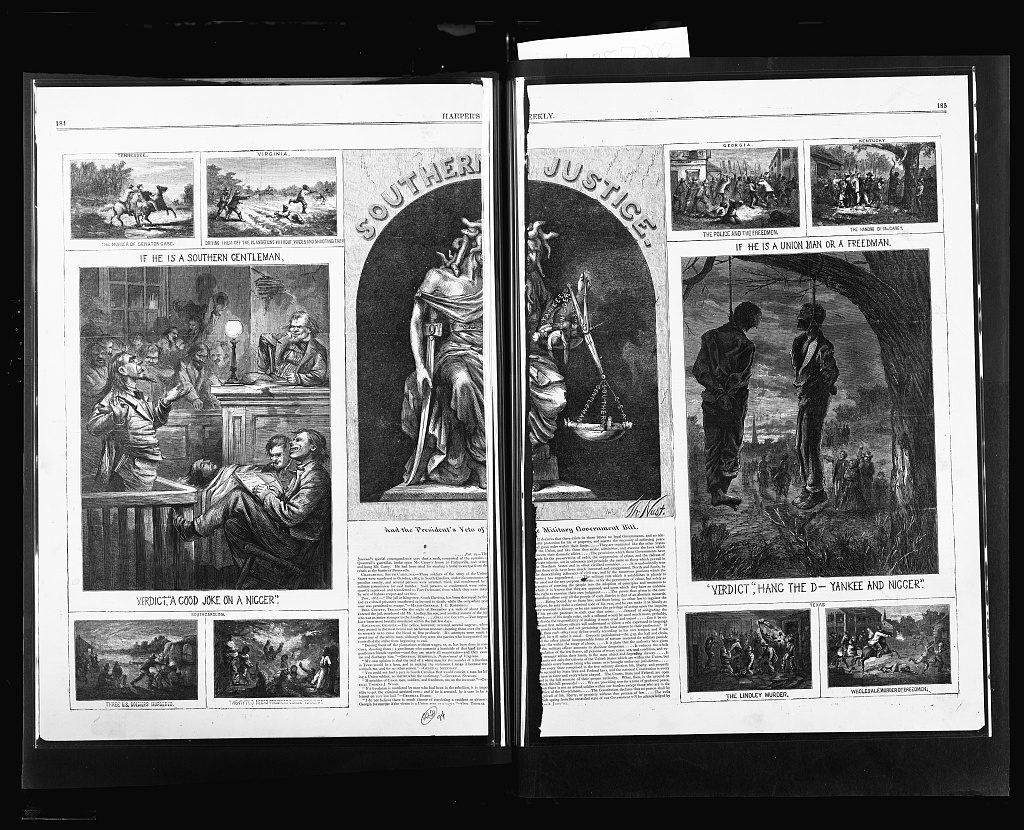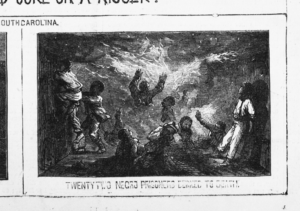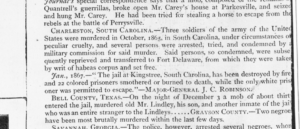On January 7, 1867 the jail in Kingstree, South Carolina caught on fire. Twenty-two black prisoners were burned or smothered to death.
From The New-York Times January 16, 1867:
The Burning of the Kingstree, S.C., Jail – Heartrending Scenes Attending the Death of the Inmates – Ineffectual Attempts to Save Them.
From the Charleston Courier, Jan. 11
We have deferred giving place in our columns to any of the numerous rumors which have reached the city in regard to the distressing calamity which occurred at Kingstree on Monday night, in the hope that the reports would prove exaggerated: … [but now there is an “authentic statement”] …
We learn that Gen. SCOTT has dispatched an officer of the Freedmen’s Bureau to the scene of the disaster to inquire into the circumstances under which it occurred.
We copy the following account of the fire from the Kingstree Star of Wednesday:
“We are called upon to record one of the most horrifying and melancholy accidents which has ever occurred within the limits of this State. Though an accident which no caution or foresght [sic] could avoid, it will send a thrill of horror throughout the whole country. On the evening of the 7th inst., between the hours of 8 and 9 P.M., the occupant of the jail heard very suddenly a rumbling noise
in the upper stories of the jail, as if the iron grates were being shaken, and immediately followed by the cry of fire. He rushed from his room to ascertain whether the jail was on fire or not, and after walking around the jail he observed a little smoke issuing from one of the windows on the third floor. … [The occupant sent for the jailor, who lived several hundred yards away and who had the keys to the jail. The jailor and sheriff soon arrived.]
The Sheriff, with the assistance of nearly all the citizens in the village and the garrison at this place, immediately took the most active measures to save, if possible, the unfortunate inmates. … [But there was too much smoke to use the stairs in the building, and the would be rescuers used ladders on the outside but couldn’t remove the grating from a window.]
At this time the cries and screams of the suffering inmates were heart-rending. The jail was in flames, and twenty-two human beings were being burnt to death, without any possible relief. Human agency could effect nothing; every effort was made to rescue them which could be suggested, but all to no purpose. … [only bones remained in the charred ruins only the bones remained]
[Twenty-two negroes, including three women, died on the third floor. Mr. MCBRIDE saved a white man who was confined on the second floor for bail process; Mr. MCBRIDE almost suffocated during the rescue.]
[Many people acted heroically, but especially] the superhuman efforts of Lieut. ROSS, private WM. GREEN, (who mounted a ladder at the most perilous crisis, and ascended to a window on the third story,) Sheriff MATTHEWS and Mr. BECK, JOE and WILLIAM BLABELY, (colored,) particularly excited our commendation.
As to the origin of this fire we can only conjecture. Whether it was accidental or designed by the prisoners for the purpose of making their escape is one of those mysteries that will remain unexplained. A jury of inquest is now sitting for the investigation of the whole matter, but up to the time of going to press they had not rendered their verdict.”
It’s all a mystery to me. The only other mention I found of Kingstree at The New-York Times archives for the rest of 1867 and 1868 was a paragraph in the February 5, 1867 issue that referenced the January 30th issue of the Kingstree Star: Two men “who were arrested by order of the military on account of the death of the negroes in the burning of the Kingstree jail, have been released from Castle Pinckney, where they were confined.” A District Judge requisitioned a transfer of the prisoners to civil authorities.
In the March 23, 1867 issue of Harper’s Weeekly Thomas Nast included the Kingstree jail fire in a cartoon lampooning “Southern Justice”. He drew the fire over a caption “TWENTYTWO NEGRO PRISONERS BURNED TO DEATH.” The text with the cartoon quotes General John C. Robinson saying the white prisoner “was permitted to escape.”



